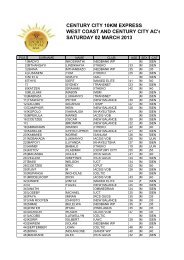Chapters 1 to 11 Combined - Century City
Chapters 1 to 11 Combined - Century City
Chapters 1 to 11 Combined - Century City
Create successful ePaper yourself
Turn your PDF publications into a flip-book with our unique Google optimized e-Paper software.
SIGNAGEAs a mixed use development,<strong>Century</strong> <strong>City</strong> needs <strong>to</strong> accommodatesignage that imparts a sense ofquality and vibrancy, withoutdetracting from the amenity of theenvironment. For this reason signageis subject <strong>to</strong> approval by the DesignReview Committee, and must complywith the policy laid down forsignage.Signage should provide easilycomprehensible orientation andinformation. Signs are visual aidsthat provide a person withinformation about the local area andhow <strong>to</strong> use it. Such visualinformation should be aestheticallypleasing and effective ascommunication. Systematic signageis important <strong>to</strong> ensure validity of thesignage hierarchy over time.Commercial advertising is aninevitable component of urbansignage. It is part of a freeenterprise society that promotescompetition and choice. Commercialadvertising can produce anenvironment that is lively, colourfuland stimulating if carefully managed.But if pursued recklessly suchsignage can often compete with, anddetract from, the quality of theurban environment.The impact on urban quality andcharacter is the reason whycommercial advertising is regulatedat <strong>Century</strong> <strong>City</strong>. The task ofregulation is essentially an aestheticone, in which the extent,character, size and position ofa commercial sign ismeasured against the loss ofamenity or environmentalquality.Aims of the signage policy are<strong>to</strong>:a) facilitate directionfinding, maintain clearcommunication andpromote orientation inthe public realm;b) impart a sense ofvibrancy and interestabout the project;c) contribute <strong>to</strong> the qualityof the project throughthe style, image andvisual consistency of thesigns;d) regulate commercialadvertising <strong>to</strong> promoteenvironmental qualityand urban character;e) prevent a proliferation ofjarring/clashing/loudsigns and lights whichcreate visual conflict anddetract from the urbanand natural environment.Private Realm SignageAll externally located buildingor site signage must besubmitted <strong>to</strong> the POA andDesign Review Committee forapproval. For designerspursuing a conventionalapproach, there are a fewsimple rules, which areobtainable from the <strong>Century</strong><strong>City</strong> Property Owners’Association. These include:• recognition of the hierarchyof signage,• limits on the number andsize of signs,• relationship of the sign <strong>to</strong>the architectural form ofthe building,• policy regarding namingrights,• requirements fordevelopment andcontrac<strong>to</strong>r’s boards.Designers who are interestedin innovative solutions <strong>to</strong>signage may submit proposalswhich must be supported bymotivation drawings andpho<strong>to</strong>graphs indicating thedesign of the sign. This mustinclude an explanation of the contextin terms of signage precedent andlocality, and demonstrate thecommunication aim, aesthetic meritand technical detail of the proposal.Public Realm SignageSignage in the public realm isorganized by locality and position inthe urban hierarchy whichestablishes precedence among signs.This hierarchy comprises:• <strong>Century</strong> <strong>City</strong> as a whole,• Precincts and zones• Blocks and streets• Complexes of buildings• Buildings• Temporary signs.PLANNING PARTNERS: CENTURY CITY URBAN DESIGN FRAMEWORK Oc<strong>to</strong>ber 2005 52 REVISION 1





